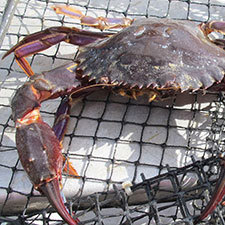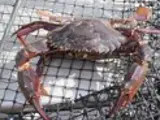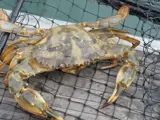 Asian Paddle Crab
Asian Paddle Crab
Common name: Asian paddle crab
Botanical name: Charybdis japonica
Management programme: Progressive Containment
Where are they originally from?
Usually found on the coast of Japan, Korea, and Malaysia, Asian paddle crabs were first detected in New Zealand in 2000. The Asian paddle crab is an aggressive defender of its territory making it a fierce competitor for native crabs and potentially giving humans a nasty nip.
Why are they a pest?
- Asian paddle crabs eat commercially and culturally important shellfish species.
- They can carry diseases that affect commercial shellfish fisheries.
- Compete with native crabs for space and food.
- Females can produce 85,000 eggs per year.
Where are they found?
- In 2018 two Asian paddle crabs were caught in the Tauranga Harbour near the Matapihi rail bridge. An ongoing trapping programme is carried out in both the Tauranga and Ōhiwa Harbours to monitor for Asian paddle crabs.
- Asian paddle crabs have been found in a number of harbours in the North Island including Waikare inlet in Northland, Whangarei, Waitemata, Tauranga harbour and as far south as Ōhiwa Harbour.
- In tidal and sub-tidal to depths of 15m. It primarily prefers estuaries where there is firm or fine muddy sand.
- The larvae can float in the water for three to four weeks, during which time they can move large distances by tides and currents.
- It can be spread by its larvae being held in ballast water or as hull fouling.
What do they look like?
- Shell width up to 12cm – much larger than most native crabs.
- Black tips of the pincers.
- It has six distinctive spines on each side of its shell below the eyes and five prominent spines on the upper surface of each claw.
- Flattened swimming paddles on back legs with colour varying between pale green, dark green, brown and purple.
What are the rules?
Progressive Containment
Progressive Containment species are pests which the Council aims to prevent from spreading, reduce the distribution, or eradicate within parts of the region over time. Landowners or occupiers are responsible for the control of Progressive Containment species on their property. Council may enforce the control of these pest species.
The rules around keeping boat hulls clean and preventing the movement of marine pests:
- Keep your boat bottom and any niche areas clean (no more than light slime, all the time).
- Keep your anti-fouling paint fresh - manufacturers usually recommend replacement every 1-2 years.
- Check your hull before you travel to a new area, every time.
- If your boat is heavily fouled, haul it out. Cleaning underwater will only spread any pests that may be hiding on there.
How do you get rid of them?
It is important to ensure vessels are clean from invasive pests before entering the Bay of Plenty.
If you spot an Asian Paddle crab in the Bay of Plenty, please kill it, keep the sample and contact the Bay of Plenty Regional Council on 0800 STOP PESTS (0800 786 773).
Images


